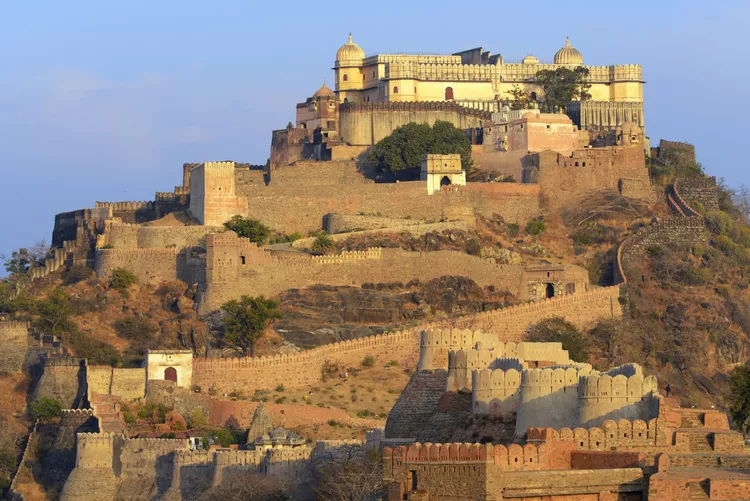1. Introduction
The 15th century Kumbhalgarh Fort in Rajasthan is one of the popular desert state’s lesser-known historical masterpieces. Yet, it’s of extraordinary significance. You may be surprised to discover that the mammoth wall of this UNESCO World Heritage Site is the second longest continuous wall in the world (after the iconic Great Wall of China), earning it the title of “Great Wall of India”. Mughal invaders found it impossible to penetrate the fort, which provided refuge for its rulers in times of attack.
2. History
Kumbhalgarh is named after Mewar king Rana Kumbha, who built it from 1443 to 1458. During his reign, the king focused on fort planning and architecture, introducing many innovations in medieval Rajput fort design. This included strengthening the walls of Chittorgarh Fort. It’s said that the site of Kumbhalgarh Fort was originally settled by Jain prince Samprati in the 2nd century BC, owing to its strategic importance and commanding view from its lofty hilltop position.
The wall snakes for an astonishing 36 kilometers (22 miles) over 13 hills, a protective boundary unprecedented in fort architecture. Unfortunately, Rana Kumbha was killed by his son Udai Singh I in 1468, leading to a decline in the fort’s prominence for several decades. However, it regained its significance when Udai Singh II sought refuge there during threats from Sultan Bahadur Shah of Gujarat.
Moreover, the fort’s involvement in the history of the Rajput kings continued; Maharana Pratap, known for his valiant resistance against the Mughal Empire, was born here. Despite various attempts by the Mughals to capture Kumbhalgarh, they failed repeatedly until they resorted to poisoning its water supply in 1579. The fort’s importance continued to diminish until it was returned to the Mewar kings in the 19th century when Maharana Bhim Singh signed an alliance treaty with the British East India Company.
Restoration efforts led by Maharana Fateh Singh from 1884 to 1930 helped reinstate Kumbhalgarh’s architectural grandeur. Following India’s independence, Kumbhalgarh was designated a protected monument under the Archaeological Survey of India.
3. Location
Kumbhalgarh Fort is situated within Kumbhalgarh Wildlife Sanctuary, just over two hours north of Udaipur in the Aravalli Hills of Rajasthan’s Rajsamand district. It sits at the boundary of the erstwhile kingdoms of Mewar and Marwar, enhancing its historical significance.
4. How to Get There
Kumbhalgarh is commonly visited on a day trip from Udaipur. Travelers can hire a car and driver from various travel agencies in Udaipur, with costs typically ranging from 2,800-3,600 rupees for a full day. For budget-conscious visitors, buses depart every hour from Chetak Circle in Udaipur to Kelwara village near the fort, costing approximately 50 rupees and taking about three hours. Performers can take a local jeep taxi from Kumbhalgarh Circle to the fort entrance.
The fort opens daily from 8 or 9 a.m. to 5 or 6 p.m., with entry tickets priced at 40 rupees for Indians and 600 rupees for foreigners. Free entry is provided for children under 15 years old.
5. What to Do There
Plan to spend three to four hours exploring Kumbhalgarh Fort. The site requires some uphill walking, as vehicles are not permitted inside. Guides are available at the entrance for a fee, or visitors can explore independently. With over 360 temples mostly dedicated to Jain deities, visitors will encounter a multitude of historical structures. Key attractions include Kumbha Palace, Jhalia ka Malia, and Badal Mahal, the topmost palace.
Visitors are particularly enchanted by the fort’s ambiance around sunset, when its structures are beautifully illuminated. Those interested in further learning can attend the evening sound and light show, which typically starts after sunset and runs for about 45 minutes. Tickets for this captivating experience are priced at 118 rupees for adults and 49 rupees for children.
For the more adventurous, hiking the fort’s impressive wall or participating in the Kumbhalgarh-Ranakpur trek through the adjoining wildlife sanctuary is an exhilarating option. Annual events such as the Kumbhalgarh festival also showcase folk performances and traditional games.
6. Where to Stay
The Aodhi, owned by the Mewar royal family, is the most renowned hotel in the area, offering amenities such as an outdoor swimming pool and horse riding. Prices start from approximately 6,000 rupees per night. Club Mahindra’s resort at Kumbhalgarh is ideal for families, with rates starting at 10,000 rupees per night, including breakfast.
Additionally, Fateh Safari Lodge appeals to outdoor enthusiasts and offers luxurious accommodations from 5,000 rupees per night. There are several other new luxury resorts in the area, with rates starting around 6,000 rupees per night.
For those seeking budget options, Hotel Kumbhal Palace is close to the fort with decent accommodations priced between 2,500-3,500 rupees per night. Alternatively, Kelwara village offers various cheaper stays, including New Ratan Deep Hotel and Karni Palace Hotel.





